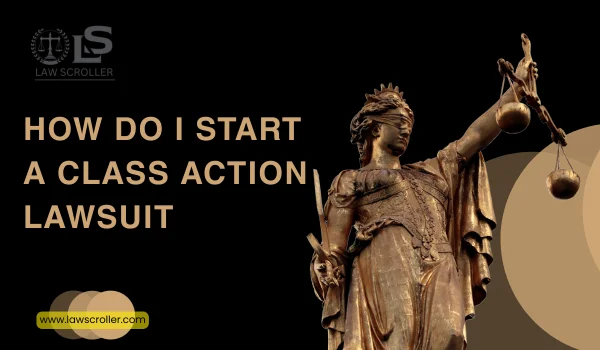You’ve probably seen headlines about big class action lawsuits—whether against drug companies, car manufacturers, or large retailers. These cases matter because they give ordinary people the power to stand up to big corporations. Instead of one person fighting alone, a class action combines many people with similar complaints into one case.
But what if you’ve been harmed and are wondering, “How do I start a class action lawsuit?” This guide will break it down step by step in simple, everyday language.
Background: What Is a Class Action Lawsuit?

A class action lawsuit is a legal case where a group of people with the same or very similar problems sues a company or organization together.
- Who files it? Usually, one or more individuals act as the “lead plaintiffs.” They represent everyone in the group.
- Who’s involved? The defendants are often big companies—like banks, drug makers, or tech firms—that allegedly caused harm to many people.
- Why class actions exist: Without them, each person would have to file a separate lawsuit, which could be expensive and time-consuming.
In plain English: a class action helps level the playing field when a lot of people have been treated unfairly in the same way.
Who’s Affected or Eligible?
Not everyone can start or join a class action. You may be affected if:
- You bought a product that turned out to be defective or dangerous.
- You took a medication that caused harmful side effects.
- You were charged unfair fees by a bank, insurer, or credit card company.
- You experienced workplace discrimination along with other employees.
In general, you’re eligible if your situation is similar to what many others faced. Courts look for patterns—one person’s bad experience usually isn’t enough for a class action.
Steps to Start a Class Action Lawsuit
If you believe you have a case, here’s what usually happens:
- Contact an Attorney – Look for a lawyer who specializes in class actions. Most offer free consultations.
- Case Evaluation – The lawyer will check if your case meets the requirements: common issues, large group of affected people, and damages.
- Filing the Lawsuit – If it looks strong, the lawyer files a complaint in court on behalf of you and others.
- Class Certification – A judge must approve it as a class action. This step decides whether the case officially represents a group.
- Notification – Other potential class members are informed and given the option to join or opt out.
- Court Proceedings – The case moves forward like any lawsuit: evidence, hearings, negotiations.
- Settlement or Trial – Most class actions end in settlements, where the company pays money without admitting fault.
Simple Timeline of a Class Action
- Step 1: Contact a class action lawyer (Day 1).
- Step 2: Lawyer investigates and files the complaint (Weeks to Months).
- Step 3: Court reviews and decides on class certification (Months to a Year).
- Step 4: Notice goes out to potential class members (After Certification).
- Step 5: Settlement talks, hearings, or trial (1–3+ years).
- Step 6: Payments or remedies distributed (After Final Approval).
What’s at Stake?
Starting or joining a class action lawsuit isn’t just about money. Here’s what could be on the line:
- Compensation: Refunds, medical expenses, or financial damages.
- Justice: Holding big companies accountable for wrongdoing.
- Policy Change: Some lawsuits force companies to change harmful practices.
- Consumer Protection: Cases can set precedents that protect future customers or employees.
What to Watch Next
If you’re considering action or just following a case, keep an eye on:
- Class Certification Decisions – Without certification, the case cannot move forward as a class action.
- Settlement Talks – Many companies settle to avoid lengthy trials.
- Deadlines to Join – Courts set cut-off dates for people to join the class.
- Final Approval Hearings – Judges must approve settlements before payments are distributed.
FAQs
- Am I eligible to start a class action?
Yes, if you and others have suffered the same kind of harm from the same company. A lawyer will help decide if it qualifies. - Do I need a lawyer?
Absolutely. Class actions are complex, and only a lawyer experienced in this area can properly file and manage the case. - How long does it take?
Class actions often take years, sometimes 2–5 years or more, depending on the size and complexity of the case. - How much money could I get?
It depends. Some settlements pay a few hundred dollars per person, while others award thousands. The lead plaintiffs sometimes get extra compensation for their role. - Will it cost me money to join?
Usually no. Most class action lawyers work on a “contingency fee” basis, meaning they only get paid if the case wins or settles. - Can I opt out if I don’t like the settlement?
Yes. Courts allow you to opt out and file your own lawsuit if you prefer, but you won’t get money from the class action settlement.
Final Thoughts
A class action lawsuit is a powerful way for ordinary people to take on big corporations. It helps ensure that companies can’t get away with unfair practices just because each individual claim might seem small. If you think you’ve been wronged in the same way as many others, contacting a qualified class action attorney is the first step.


 Oliver Johnson is LawScroller’s Senior Legal Correspondent specializing in civil litigation, class actions, and consumer lawsuit coverage. He breaks down complex settlements and court decisions into clear, practical guidance for readers.
Oliver Johnson is LawScroller’s Senior Legal Correspondent specializing in civil litigation, class actions, and consumer lawsuit coverage. He breaks down complex settlements and court decisions into clear, practical guidance for readers.